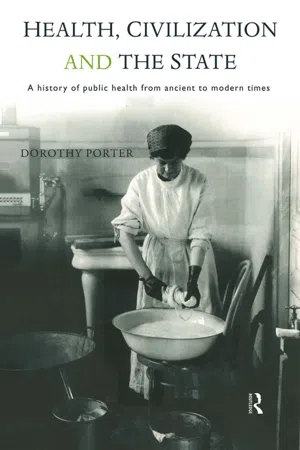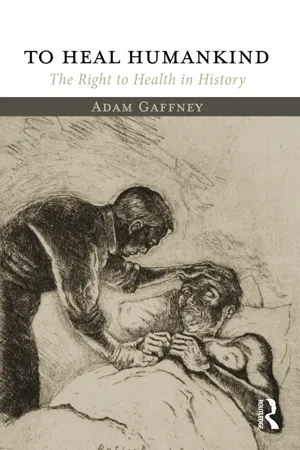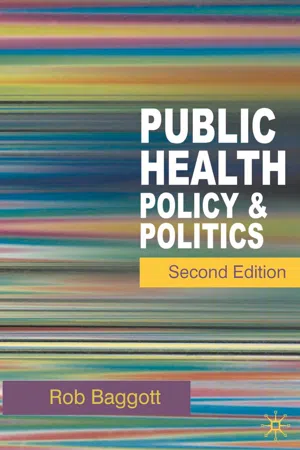History
Public Health in Early Modern Britain
Public health in early modern Britain focused on efforts to improve sanitation, control infectious diseases, and provide medical care to the population. This period saw the emergence of public health legislation, such as the creation of boards of health and the implementation of quarantine measures. Public health initiatives aimed to address the environmental and social factors impacting the health of communities.
Written by Perlego with AI-assistance
Related key terms
8 Key excerpts on "Public Health in Early Modern Britain"
- eBook - ePub
The Cult and Science of Public Health
A Sociological Investigation
- Kevin Dew(Author)
- 2012(Publication Date)
- Berghahn Books(Publisher)
It is around this time that Johann Peter Frank was advocating the establishment of medical police in the German-speaking states. The view was emerging that population health was vital to the health of the state as a whole: a healthy, fit population of men and fertile, healthy women create a strong, productive and competitive state. For the next two hundred years or so, this was to become a strong argument for adopting public health measures.George Rosen argued that the development of medical police was symptomatic of a centralized and despotic form of governance common to the German-speaking states. In contrast, medical police would be in conflict with the more laissez-faire approach to governance of eighteenth- and nineteenth-century Britain (Rosen 1993). In comparison with the German-speaking states, the development of public health in Britain was characterized by a great deal of tension with commercial interests. On one hand, there was anxiety that any centralized form of public health would infringe upon the liberal tradition and the individual, and the commercial rights it championed. On the other hand, there was considerable disquiet over the appalling living conditions of a large section of British society.These appalling living conditions were in part a result of the rapid urbanization that accompanied the industrial revolution. The industrial revolution brought about a spectacular growth in urban centres, with London experiencing a six-fold increase in the population (Halliday 2007). During the nineteenth century the growth of cities and the impacts of industrialization led to shifts in thinking about responsibility for health. It was no longer considered a wholly private matter, but now increasingly regarded as requiring government action (Hardy 2001). This was clearly seen in the development of compulsory vaccination legislation, but also in the increasing use of epidemiology to describe national disease pictures and encourage public health interventions. Prior to the Public Health Act of England and Wales in 1848 governments had responded to public health issues by using decrees, whereby in response to epidemic diseases beds could be burnt, houses fumigated, towns whitewashed and so on. - eBook - ePub
Body and City
Histories of Urban Public Health
- Sally Sheard, Helen Power(Authors)
- 2017(Publication Date)
- Routledge(Publisher)
Hence, the identification of a collective well-being with the market economy and family system has been implicit in basically all definitions of public health problems and in responses to them. 3 Building on these insights, this chapter looks at the role which ‘scientific’ public health policy played in urban politics and governance in the early twentieth century. It is argued here that the ways in which health authorities defined environmental problems or ‘social diseases’ such as tuberculosis, infant mortality and venereal diseases did not only help to maintain the capitalist economic system and the family in general, but they also served to legitimate different national and local arrangements in the fields of economy, politics and morals. In illustrating and analysing urban health problems – in making the unknown known – authorities reinforced, both wittingly and unwittingly, existing relationships of power and structures of inequality. 4 This chapter begins by discussing the ways in which health authorities ‘mapped’ cities in the late nineteenth and early twentieth centuries, and the political assumptions underlying these maps. In Birmingham, where suburbs – or more precisely the interdependent relationship of slums and suburbs – crucially contributed to the political and economic power of the middle class, the definition of public health problems, both in the nineteenth century and early twentieth century, served to reinforce the impression of a segregated city - eBook - ePub
Health, Civilization and the State
A History of Public Health from Ancient to Modern Times
- Dorothy Porter(Author)
- 2005(Publication Date)
- Routledge(Publisher)
The British state was relatively slow to begin considering issues of population health. As we have seen, powerful civil and maritime quarantine laws had been developed by a number of European states since the time of the Black Death. In Tudor England, Cardinal Wolsey had looked enviously at governmental modernization on the Continent and was the first British administrator to imitate it when he encouraged the development of preliminary plague regulations. By the seventeenth century, complex civil plague controls had been established by sophisticated administrations in city-states such as Florence and Venice. From the late seventeenth century, interest in population health escalated in Britain, promoted largely by philanthropic gentlemanly scholars concerned to apply social theory to a practical object. Political arithmetic, theories of the health advantages of ventilated interiors, civil administration of smallpox inoculation and the environmental improvement of towns as the basis for self-improvement of individuals were all subjects explored to various degrees within the enlightened culture of the fastest-growing consumer society in Europe. England pioneered mass inoculation for profit, along with commercial refuse removal and street improvements.From the end of the eighteenth century, the question of the people's health in Britain became bound to the changing role of the state in the transition to an industrial society. After 1815, the public purse, relieved of the burden of massive military expenditure on war, became increasingly dedicated to domestic social policy. Public health policy was a beneficiary of this development. In Britain, rapid industrialization transformed the demographic structure and geographical distribution of the population and escalated urbanization (Woods and Woodward, 1984 - eBook - ePub
- Mary Northrop, Jayne Crow, Sarah Kraszewski(Authors)
- 2015(Publication Date)
- Routledge(Publisher)
BCE ). The first modern development of organisations for public health can be attributed to Edwin Chadwick (1800–90) who conducted surveys of living conditions of the urban poor in Victorian cities, reformed the poor law system and local councils to provide a range of regulation of public health hazards (such as slaughterhouses, burials and mains water supplies) and established the profession of ‘sanitary inspectors’, now known as environmental health officers. Technical developments in sewer building and the development of theory were important in establishing our understanding of the processes of infection.European countries with world empires, during the late nineteenth century, were particularly interested in protection of the public from diseases found in the tropics such as malaria and dysentery, which resulted in the development of colonial medicine. It was from research into germ theory that we discovered that infection was spread through water and other agents (or vectors) rather than in the air (the name ‘malaria’ literally means ‘bad air’). As a result of scientific developments, a biomedical phase of public health led to the dominance of public health medicine at the beginning of the twentieth century.More recent phases of public health result from understanding of the influence of social inequality, and lifestyle in life expectancy and the distribution of disease and ill health. A widespread recognition of the limitations of medical interventions in the 1980s and acknowledgement of the importance of social determinants of health have resulted in a more broadly based approach to public health, including political solutions in public policy.Definition
Let us start by considering what we mean by public health. It is what it says – the health of the public – but what does that mean in practice? First, it is an approach that considers populations, not individuals. The ‘public’ are communities that can be geographically defined (such as ‘Londoners’ or the Northeast), or sections of a population (such as premenopausal women or manual workers who smoke) and categories of a population that can be compared, for example on the grounds of age, sex, racial or cultural group. Health (or well-being, which largely means the same thing) is about not being ill. Given that most health service provision is about ill health perhaps local services should be renamed ‘injury and illness services’, rather than health centres. Each population is likely to have different needs and require particular services. - eBook - ePub
The Evolution of the British Welfare State
A History of Social Policy since the Industrial Revolution
- Derek Fraser(Author)
- 2017(Publication Date)
- Bloomsbury Academic(Publisher)
© Derek Fraser 2017 Derek Fraser The Evolution of the British Welfare State https://doi.org/10.1057/978-1-137-60589-4_4Begin AbstractEnd Abstract4. Public health
SummaryThe rapid growth in population and its concentration in industrial cities lacking the basic infrastructure of water supply and sewerage created new public health problems. Medical science had not yet discovered the germ theory of disease, but Edwin Chadwick was able to demonstrate in his famous 1842 Sanitary Report that there was a causal relationship between the urban environment and life expectancy. He advocated new legislation and the water-borne disposal of sewage and was partially successful in the passing of the 1848 Public Health Act. Public health reform raised important ideological issues about the rights of property, centralisation and local self-government. In the mid-Victorian years much progress was made in public health administration, mainly at the local level, under the leadership of Simon, effectively the first national Medical Officer of Health. By the end of the century there was comprehensive legislation and local public health institutions, and the death rate fell. Historians debate the role of public health in increasing life expectancy, as against rising wages and improving diet and living standards.4.1 I The nature of the problem
In many ways, despite periodic visitations of bubonic plague, there was no real public health problem in pre-industrial England. London and the centres of some of the provincial market or cathedral towns contained cramped houses, but the vast majority of the population were spread thinly over the rural areas. It was the Industrial Revolution, accompanied by a massive shift in population from rural to urban areas, which created a public health problem. As with so many other social questions, it was the very concentration of people which caused the difficulty. It was only in the so-called age of great cities that society needed that essential combination of preventive medicine, civil engineering and community administrative and legal resources known by the generic term ‘public health’. - eBook - ePub
To Heal Humankind
The Right to Health in History
- Adam Gaffney(Author)
- 2017(Publication Date)
- Routledge(Publisher)
11Indeed, public health as a scientific field is often traced back to the early industrial era in France.12 Just as it is today, public health was an unavoidably and indeed intrinsically political undertaking, and its practitioners were clearly influenced by prevailing economic and political discourses.13 As the historian Ann La Berge explains, the public health movement of this era was suffused by a “dialectic between liberalism and statism” that echoed a larger division between liberalism and what has become known as “social medicine.”14 The liberal approach had deep philosophical roots. The French liberal economist Jean-Baptiste Say (1767–1832), for instance, argued that the fundamental laws of economics were an unchanging and unchangeable fact, and that any form of charity—whether public or private—should not be extended to the working poor.15 The era also saw the rise to prominence of the icy ideology of Thomas Robert Malthus (1766–1834). In his Essay on the Principle of Population , aimed explicitly at Enlightenment optimists like Condorcet, Malthus not only disputed the notion of the “perfectibility” of humankind, but also contended that suffering, want, famine, poverty, and so forth were the inevitable product of the laws of nature.16 His thesis rested on the premise that the rate of population growth (if not contained) would always outpace the rate of growth of food production (given a fixed quantity of land).17 However, various forces maintained equilibrium and prevented the poor from overpopulating the earth. One was the “preventive check,” in which the poor, cognizant of their lack of food, prudently eschewed sex. If the preventive check failed, however, the “positive check” went into operation, which consisted of such necessities as “sickly seasons, epidemics, pestilence, and plague,” with “gigantic inevitable famine” available as nature’s last resort.18 - eBook - ePub
Public Health
Policy and Politics
- Rob Baggott(Author)
- 2010(Publication Date)
- Bloomsbury Academic(Publisher)
Although Parliament was a key battleground between public health reformers and their opponents in the Victorian era, local government was also an important arena. The 1848 Act was permissive in all but the most exceptional circumstances. This meant that decisions about public health were delegated to local communities, stimulating political divisions at this level. Efforts to impose a central framework for regulation were vigorously resisted. Indeed, according to some (Szreter, 1995, cited in Baum, 2002, p. 19) the 1840s were ‘a false dawn’ for the public heath movement, which failed to win over the governing classes. In the longer term, however, the impetus proved too powerful. The crucial change was the 1866 Sanitary Act, which imposed obligations on localities to cleanse their communities, although local communities continued to have considerable autonomy within this framework.The Public Health Act of 1875 represented the culmination of the sanitary reformers’ campaign. Although a consolidating measure, it set a clear framework for public health for the next fifty years. It also signalled the end of an era, for although legislation would still be used to improve the physical environment, attention was shifting towards other means of intervention aimed at improving social welfare generally and personal hygiene in particular.Victorian Public Health: Preventive Medicine
In the latter part of the Victorian period, ‘preventive medicine’ replaced the ‘sanitary idea’ as the dominant philosophy of public health (see Armstrong, 1993; Kickbusch, 1986; Fee and Porter, 1992; Lewis, 1992). This was manifested in the ‘medicalization’ of public health; in a shift in the focus of attention from the general population towards specific subgroups and individuals, and in an increasing emphasis on access to health services. At the same time, the activities of the sanitary movement, while still contributing to public health debates, became more closely integrated with broader issues of social welfare.It should be noted that Chadwick had a ‘deep-seated distrust of curative medicine’ (Finer, 1952, p. 157). Indeed, the early Victorian public health programme was ‘fundamentally environmentalist’ (Sheard and Donaldson, 2006, p. 1). Medicine played a secondary role to other professions, such as engineering for example. As already mentioned, medical professional bodies were less than enthusiastic about central government intervention. Nonetheless, individual members of the medical profession were an important driving force behind the sanitary revolution. Much of the early evidence about the extent of the problem was documented by individuals with a medical background, such as Farr, Southwood Smith and Simon. - Tony Moore, Raj Lakha(Authors)
- 2007(Publication Date)
- Routledge(Publisher)
7
Historical Context of Environmental Health and Communicable Disease Control within the UK
In this chapter:• Introduction.• Concise history of infectious disease in the UK.• Food Safety.• Present day management and control of infectious disease.• Case study: Mary Mallon (Typhoid Mary) – a healthy carrier.• Legal and practical control of food poisoning.• Food hazard warnings.• Legislative control of food borne communicable disease.• Control of public health pests.• Legislative control of food safety.• Severe Acute Respiratory Syndrome (SARS).• Avain Influenza.7.1 Introduction
The roots of environmental health are fragmented in nature, whose origin can be traced to the late eighteenth century. The Industrial Revolution resulted in major shifts in populations from rural to industrial environments predominately in the larger towns and cities. This resulted in rapid expansion in the size and population of industrial towns. The need to house the industrial inhabitants was great, placing enormous pressure on the existing industrial housing stock. The problems of housing people and providing them with adequate food, water and facilities to remove sewage allowed several killer diseases to spread with terrifying ease. The need to relocate industrial workers close to their workplace had two major effects in relation to human health. The first was the proliferation of high-density housing. Multi-family occupancy of single rooms were not uncommon, such dwellings often lacked basic amenities such as wholesome water supply and water closets. The second was the general absence of effective planning laws, which allowed the placing of domestic properties in the close proximity of the polluting factories.7.2 Metropolitan life
Public utilities struggled to maintain adequate water supply and drainage systems for the expanding towns. Excessive demand in relation to the inadequate supply led to generalised water shortages. The transmission of waterborne communicable diseases was facilitated by these conditions. The inadequacy of municipal drainage systems encouraged the depositing of polluting matter from industrial and domestic effluent into watercourses, which were used to transport the effluent to the sea. It has been argued that the development of sewers were neither inevitable nor even the best possible solution to the problem of waste disposal. The first paradigm of sewage being merely inconvenient ‘run off’ and sewers being open streams had to be redefined as ‘dangerous pollution’ and ‘underground waste disposal pipes’ respectively. The growing early community of civil engineers needed to change existing environmental and cultural perceptions with technical ones. Sewage became a hazardous by-product of metropolitan life, which engineers had designed a system of pipes, reproducing and relocating polluted streams that had once constituted the natural drainage systems (see Porter D H The Thames Embankment Environment, Technology and Society in Victorian London
Learn about this page
Index pages curate the most relevant extracts from our library of academic textbooks. They’ve been created using an in-house natural language model (NLM), each adding context and meaning to key research topics.







